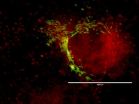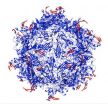One step closer to cell reprogramming
2014-05-06
(Press-News.org) In 2012, John B. Gurdon and Shinya Yamakana were awarded the Nobel Prize in medicine for discovering that adult cells can be reprogrammed into pluripotent ones (iPS); the cells obtained are capable of behaving in a similar way to embryonic stem cells, and hence have enormous potential for regenerative medicine.
However, although there are many research groups around the world studying this process, it is still not completely understood, it is not totally efficient, and it is not safe enough to be used as the basis for a new cell therapy.
Now, researchers at the Centre for Genomic Regulation (CRG) in Barcelona have taken a very important step towards understanding cell reprogramming and its efficiency: they have discovered the key role of the Wnt signalling pathway in transforming adult cells into iPS cells.
"Generally, transcription factors are used to try to increase or decrease the cell reprogramming process. We have discovered that we can increase the efficiency of the process by inhibiting the Wnt route", explains Francesco Aulicino, a PhD student in the Reprogramming and Regeneration group, led by Maria Pia Cosma and co-author of the study that has just been published in Stem Cell Reports.
The Wnt signaling pathway is a series of biochemical reactions that are produced in cells. In frogs or lizards, for example, these reactions are those that allow their extremities to regenerate if the animal suffers an injury. Although in general, humans and mammals have lost this regenerative capacity, the Wnt pathway is involved in numerous processes during embryonic development and cell fusion.
As it is in reprogramming. The researchers have studied how the Wnt route behaves throughout the entire process of transforming cells into iPS cells, which usually lasts two weeks. It is a very dynamic process that produces oscillations from the pathway, which is not active all the time. "We have seen that there are two phases and that in each one of them, Wnt fulfils a different function. And we have shown that by inhibiting it at the beginning of the process and activating it at the end we can increase the efficiency of reprogramming and obtain a larger number of pluripotent cells", indicates Ilda Theka, also a PhD student in Pia Cosma's group and a co-author of the article.
To artificially control the pathway, the group has employed a chemical molecule, Iwp2, which is a Wnt secretion inhibitor that does not permanently alter the cells, something which other research into reprogramming using different factors has still has not been able to acheive.
They have also seen that the exact moment when the Wnt pathway is activated is crucial. Doing it too early, makes the the cells begin to differentiate, for example into neurones or endodermal cells, and they are not reprogrammed.
"It is a very important and an innovative advance in the field of cell reprogramming, because until now this was a very inefficient process. There are many groups trying to understand the mechanism by which adult cells become pluripotent, and what blocks that process and makes only a small percentage of cells end up being reprogrammed. We are providing information on why it happens", says Theka.
The work opens the way to new advances in regenerative medicine and sheds light on certain types of tumours involving the Wnt pathway. Other labs are also working on ways to increase efficiency when inducing pluripotency in these cells. This is the case of the Haematopoietic Stem Cells, Transdifferentiation and Reprogramming laboratory, led by Thomas Graf, where they work on induced plurioptent stem cells (iPS).
INFORMATION:
The study was funded by the European Research Council (ERC), the Human Frontier Science Programme (HFSP), the Ministry of Economy and Competitiveness, the Fundació 'La Marató' TV3, the AXA Research Fund and the Marie Curie Ingenium Initial Training Network (ITN) programme.
ELSE PRESS RELEASES FROM THIS DATE:
Can you tell a person's gender by their video game avatar?
2014-05-06
This news release is available in French.
Montreal, May 6, 2014 — A sexy wood elf with pointy ears. A hulking ogre with blue skin. An intimidating heroine with a buxom breastplate. When it comes to computer games, players can choose to be anyone or anything. But gamers don't always mask their true identities with online avatars.
According to a new study by researchers at Concordia University, Colorado State University, Syracuse University, Hofstra University and the University of Toronto, a male gamer who chooses to play as a female character will still display ...
The Red Sea -- an ocean like all others, after all
2014-05-06
Pacific, Atlantic and Indian Ocean, with the land masses of the Americas, Europe, Asia, Africa and Australia in between – that's how we know our earth. From a geologist's point of view, however, this is only a snapshot. Over the course of the earth's history, many different continents have formed and split again. In between oceans were created, new seafloor was formed and disappeared again: Plate tectonics is the generic term for these processes.
The Red Sea, where currently the Arabian Peninsula separates from Africa, is one of the few places on earth where the splitting ...
Protein molecule may improve survival in deadly lung disease
2014-05-06
Researchers at the University of Illinois at Chicago College of Medicine have discovered a protein molecule that seems to slow the progression of pulmonary fibrosis, a progressive lung disease that is often fatal three to five years after diagnosis.
The finding is reported in the American Journal of Respiratory and Critical Care Medicine.
Nearly five million people worldwide are affected by pulmonary fibrosis, which causes the lungs to become covered in fibrous scar tissue and leads to shortness of breath that gets more severe as the disease progresses.
Chronic inflammatory ...
Two-lock box delivers cancer therapy
2014-05-06
Rice University scientists have designed a tunable virus that works like a safe deposit box. It takes two keys to open it and release its therapeutic cargo.
The Rice lab of bioengineer Junghae Suh has developed an adeno-associated virus (AAV) that unlocks only in the presence of two selected proteases, enzymes that cut up other proteins for disposal. Because certain proteases are elevated at tumor sites, the viruses can be designed to target and destroy the cancer cells.
The work appears online this week in the American Chemical Society journal ACS Nano.
AAVs are ...
Donor livers preserved and improved with room-temperature perfusion system
2014-05-06
A system developed by investigators at the Massachusetts General Hospital (MGH) Center for Engineering in Medicine (CEM) and the MGH Transplant Center has the potential to increase both the supply and the quality of donor organs for liver transplantation. In their report, which has been published online in the American Journal of Transplantation, the research team describes how use of a machine perfusion system delivering a supply of nutrients and oxygen though an organ's circulation at room temperature preserved and improved the metabolic function of donor livers in a ...
Study: Concussion rate in high-school athletes more than doubled in 7-year period
2014-05-06
COLUMBUS, Ohio – Concussion rates in U.S. high-school athletes more than doubled between 2005 and 2012, according to a new national study using data on nine team sports.
Overall, the rate increased from .23 to .51 concussions per 1,000 athlete exposures. An athlete exposure is defined as one athlete participating in one competition or practice.
The increase might appear to sound an alarm about sports safety, but the researchers suspect the upward trend in reported concussions reflects increased awareness – especially because the rates went up the most after the 2008-09 ...
Childhood obesity trends -- not time to celebrate, yet
2014-05-06
New Rochelle, NY, May 6, 2014—Despite reports in the media that the obesity rate among young children has declined dramatically during the past 10 years, that is not the conclusion reached by recent studies published in the medical literature. Those studies did, however, reveal some potentially encouraging findings, which are detailed in the Editorial "Childhood Obesity Trends: Time for Champagne?" published in Childhood Obesity, a peer-reviewed journal from Mary Ann Liebert, Inc., publishers. The article is available free on the Childhood Obesity website at http://www.liebertpub.com/chi.
"The ...
Ban cigarette filters to save the environment, suggest researchers
2014-05-06
Ban cigarette filters. Start a deposit-return scheme for used butts. Hold manufacturers responsible for clean-ups. Place warnings on packets about the impact of simply flicking one's used cigarettes away. These are among the policy measures that Thomas Novotny of the San Diego State University in the US and Elli Slaughter advocate to curb the environmental harm done through the large-scale littering of cigarette butts, packaging and matches. The suggestions are part of a review article in Springer's journal Current Environmental Health Reports.
Cigarette butts and other ...
Neutron star magnetic fields: Not so turbulent, after all?
2014-05-06
Neutron stars, the extraordinarily dense stellar bodies created when massive stars collapse, are known to host the strongest magnetic fields in the universe -- as much as a billion times more powerful than any man-made electromagnet. But some neutron stars are much more strongly magnetized than others, and this disparity has long puzzled astrophysicists.
Now, a study by McGill University physicists Konstantinos Gourgouliatos and Andrew Cumming sheds new light on the expected geometry of the magnetic field in neutron stars. The findings, published online April 29 in Physical ...
Detecting fetal chromosomal defects without risk
2014-05-06
Chromosomal abnormalities that result in birth defects and genetic disorders like Down syndrome remain a significant health burden in the United States and throughout the world, with some current prenatal screening procedures invasive and a potential risk to mother and unborn child.
In a paper published online this week in the Early Edition of PNAS, a team of scientists at the University of California, San Diego School of Medicine and in China describe a new benchtop semiconductor sequencing procedure and newly developed bioinformatics software tools that are fast, accurate, ...


